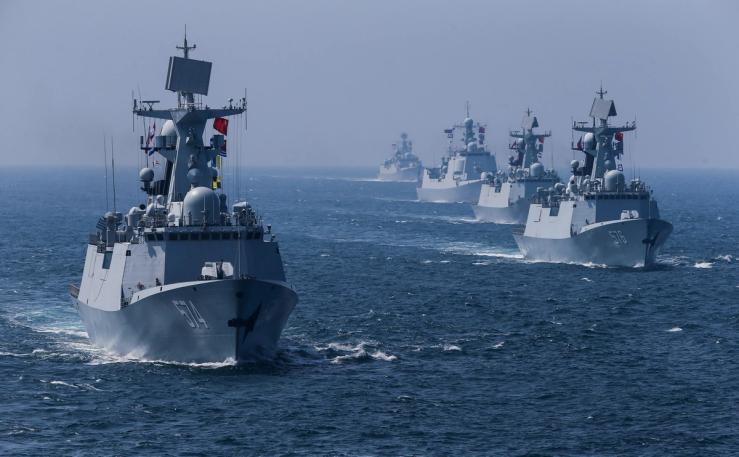Andy’s view
A powerful nation, the 19th-century US naval historian Alfred Thayer Mahan wrote, possesses a large merchant marine fleet, a blue-water navy, and a network of naval bases.
By that maritime measure, China is pulling ahead of the US. It operates the world’s largest cargo fleets and the biggest navy, and its state enterprises have invested in dozens of ports worldwide. But Beijing’s ambitions don’t stop there: China does not border the Arctic, but its icebreakers are exploring new trade routes through the melting ice cap, while Chinese expeditionary ships scour the Pacific seabed for mineral-rich nodules — a prize potentially worth trillions of dollars.
To counter all this, US President Donald Trump wants “more ships faster.”
If only it was that easy.
Last year, US shipyards built just five oceangoing vessels. China built as many as 1,700, with its largest state-owned shipbuilder producing more vessels by tonnage than the US has built in all the years since World War II combined.
Set alongside this challenge to US national security, China’s threat to choke off the supply of rare earths — the issue that forced Trump to back away from tariffs and agree to a trade truce with Chinese leader Xi Jinping last week — looks readily manageable: Scott Bessent, the US Treasury Secretary, told the Financial Times he believes the US can build an alternative rare earths supply chain in 12-24 months.
In fact, the greater danger for Washington is that China, sensing US weakness, will start weaponizing its other industrial strengths.
For almost a decade, Xi has been establishing Chinese chokeholds on critical industrial inputs that include active pharmaceutical ingredients, semiconductors, batteries, and medical imaging components. Dinny McMahon, the head of markets research at Trivium, a China advisory firm, says Xi’s strategy has been so successful that “almost any manufactured good you buy, no matter where it comes from, has some exposure to Chinese supply chains.”
In the maritime domain, China now accounts for more than half of global shipbuilding. The US: 0.2%. There are eight Chinese ports in the global top 25; the US has none. While this is perhaps not surprising — trade is a much smaller component of US GDP than China’s — American ports are also far less efficient than their Chinese counterparts; China produces about 95% of all shipping containers, and has cornered the global market in ship-to-shore cranes.
In this article:
Know More
Trump’s shipbuilding project is an attempt to wind back the clock. The last time the US significantly ramped up ship production, it was at war with Nazi Germany. Then-President Franklin D. Roosevelt invested massively in shipyards, summoned legions of naval architects, welders and pipe-fitters who had been idle since the beginning of the Great Depression, and launched the Liberty Ship program that delivered cargo vessels at astonishing speed; the SS Robert E. Peary was built in a record four days, 15 hours, and 29 minutes. Flotillas of Liberty Ships rushed supplies to Europe from the US — the “Arsenal of Democracy” in Roosevelt’s words — and helped secure the Allied victory.
China today is what the US used to be. It has scale. It has skills. Above all, it has national will, discipline, and stamina.
And nowadays, an American industrial surge of the order seen during World War II would appear to be unlikely. The US shipping industry has been in steep decline since the 1980s, when the country decided to focus on building warships — a segment in which it still excels — while neglecting commercial vessels.
The fate of a bipartisan bill that aims, in part, to create a fleet of 250 US-flagged, US-crewed, and US-built vessels — the SHIPS for America Act — points at the political obstacles to a US industrial revival. A Senate hearing last week on the long-stalled bill took place during the government shutdown. For now, all legislative progress is on hold.
And abroad, the US appears to be shifting away from partnering with allies: Why not keep outsourcing from South Korea, whose shipyards still have the technical edge over China, and Japan, a leader in areas like eco-friendly ships? The US might be better off trying to leapfrog China by developing its own high-tech niches, like nuclear-powered cargo ships. That would play to the US’ core strengths in R&D and innovation.
It will take years of skillful statecraft by Washington, not to mention domestic political horse-trading and the patient rebuilding of a hollowed-out manufacturing base, to restore some measure of parity with China. In the meantime, the US would be wise to avoid picking unwinnable trade fights with a vastly more powerful industrial competitor.
Room for Disagreement
In fairness, Trump has made a reasonable start to his campaign for more ships: Despite his bullying of allies on trade, he recognizes the US needs them for industrial expertise, and to help match China’s scale. On a swing through Asia last week, Trump secured multi-billion dollar investment deals with Japan and South Korea — the two largest shipbuilders after China — to expand American shipyards and train a new generation of US workers. Earlier, he reached a deal with Finland to supply icebreakers along with construction know-how.


